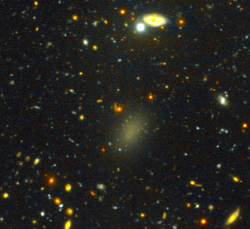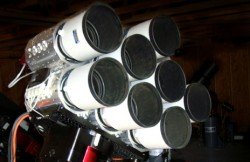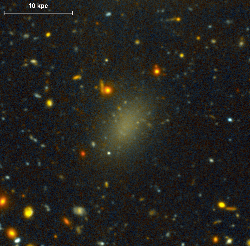A galaxy named Dragonfly 44 has been recently discovered by astrophysicists in the Coma constellation, and this galaxy has astonishing properties that have been measured two months ago. Dragonfly 44 is the ultra diffuse galaxy shown as the fainted blob in the middle of the figure below.
My post has thus nothing to do with Star Wars, the dark side and the Siths lords, but with a discovery in astrophysics (that is in my opinion as interesting as the Proxima Centauri news of last week).
 [image credits: inspire]
[image credits: inspire]
BUT WHAT IS AN ULTRA DIFFUSE GALAXY?
A couple of years ago, the Dragonfly telescope has uncovered a population of 47 large, not very bright galaxies called ultra diffuse galaxies. These galaxies are observed as red, kind of round-shaped and cannot be related to any other known class of galaxies.
Several hypotheses were postulated about these ultra diffuse galaxies, one of them considering them as failed galaxies that were prevented from building a normal population of stars due to some unknown effects.
The only way to test all those hypotheses on the market is to observe those galaxies and measure their properties. Along these lines, the first property of a galaxy that one wants to measure is its mass, and in particular the visible matter and the dark matter fractions in the galaxy.
A SHORT RECAP ON DARK MATTER
In a nutshell, dark matter is a form of matter that does not interact electromagnetically, and is thus invisible (electromagnetic interactions are connected to light). It is called dark matter:
- because we cannot see it (it is thus dark);
- because it behaves like matter (with respect to gravity).
Moreover, it does not have to be matter in the sense we usually give to this word. We actually do not know anything about the nature of dark matter.
Dark matter has been postulated in order to explain the astrophysical observations, in particular with respect to the motion of galaxies in space. Nothing more nothing less. And the only thing that we know about it is that it yields the needed effects to explain the motion of ordinary matter in space.
The hypothesis of dark matter (as well as the derivation of its distribution in the universe) is still being tested today, but it is actually the only explanation that is currently satisfactorily explaining all observations.

 [ image credits: Gemini, Yale news ]
[ image credits: Gemini, Yale news ]
THE DEIMOS APPARATUS, THE GEMINI-NORTH TELESCOPE AND THE DRAGONFLY 44 GALAXY
Earlier this year appeared the first results on the mass properties of ultra diffuse galaxies. The uncertainties were however still very large, so that no conclusive statements could be made and further experimental studies were needed.
One of such study relies on the Deimos spectrograph on the Keck-II telescope and the Gemini-North telescope both located in Hawaii. This experimental setup allows one to perform exceptionally precise and accurate ground-based imaging of the targeted galaxies, and data was recorded during about 33 hours.
The main target galaxy that was observed is called Dragonfly 44 and is the second largest of the 47 observed galaxies by the Dragonfly telescope. It is also one of the best known ultra diffuse galaxies in terms of the amount of existing measurements.
In addition, three other galaxies have also been probed simultaneously, but the results are still being analyzed and therefore not publicly available yet.
 [image credits: inspire]
[image credits: inspire]
MEASUREMENTS, RESULTS AND CONSEQUENCES
Deimos and Gemini-North data (see also a long exposure of the Dragonfly 44 galaxy in the above picture) have allowed for the extraction of the velocity of the stars lying inside the Dragonfly 44 galaxy. From there, one can infer the mass and to mass-to-light ratio of Dragonfly 44, since faster the stars move inside the galaxy, heavier is the galaxy.
The results indicate that:
- the Dragonfly 44 galaxy is much heavier than what could be inferred from its stellar composition,
- the Dragonfly 44 mass-to-light ratio is extremely large and its value is similar to those of dwarf galaxies and galaxy clusters. But Dragonfly 44 is neither a dwarf galaxy nor a galaxy cluster!
The Dragonfly 44 stars are thus way faster than what they should be from the observation of visible matter only. This allows for the computation of the dark matter fraction of Dragonfly 44, which is found to be 98%.
Dragonfly 44 is hence a galaxy of the size of the Milky Way, but with very few visible stars and a lot of dark matter in it.
Those results have ruled out many of the hypotheses attempting to explain ultra diffuse galaxy properties. And one still does not understand why stars have not been formed in such galaxies.
The mass of the Dragonfly 44 galaxy implies that one can see it as a failed Milky Way where stars have not been formed and that is instead full of dark matter.
CONCLUSIONS
A puzzle is there, and hopefully further results are coming and will solve it.
